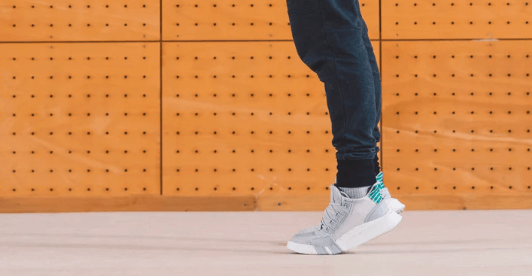The Benefits of Training With Your Heels Up

If you lift weights regularly, you’ve probably heard the advice “Keep your heels down.” Keeping your feet flat on the ground — with your weight evenly distributed between your heels and the balls of your feet — is considered by many to be the safest and most efficient stance. This form activates more muscle and allows you to lift more weight.
There are times when this rule is worth following. “When the load is up and strength and power demands are up, it makes sense to keep your feet flat,” says John Rusin, DPT, a strength-and-conditioning coach, injury-prevention specialist, and founder of the Pain-Free Performance Specialist Certification program. In other words, when you’re pulling or pushing big weights, keep both feet flat on the floor.
The rest of the time, however, consider another useful option: training with a “floating heel.”
Trainers have recently begun to recognize the huge benefits of performing lower-body movements with your weight shifted onto the balls of your feet and your heels slightly lifted.
Practicing this position prepares you for similar challenges outside the gym, says Rusin. “Very rarely does anything happen with your heels on the ground.”
Nearly all athletic movements — including jumping, running, and walking — require you to support your entire weight on the balls of your feet, and often the ball of just one foot, at least for brief periods. In theory, strength training with a floating heel can improve your stability in any activity requiring a heels-up position, leading to greater power and speed on the track, court, or trail.
It’ll also toughen the tissues of your feet and lower legs, reducing the likelihood of a twisted ankle, an Achilles tear, or another injury to your foot, shin, or knee.
“Your knee travels farther forward when you float your heel,” Rusin points out. It’s a change that emphasizes the quads — the muscles that straighten your knee and help protect the joint from injury.
Floating-heel training also offers variety — something that keeps your muscles growing and your mind engaged — without requiring you to learn an entirely new exercise. It’s a simple tweak to moves you might already know.
Rusin recommends the following progression to incorporate a heels-up element into your routine.
The Workout
WEEKS 1 TO 3: PREPARE
Perform the following two moves two or three times per week for three weeks. Incorporate them into your warm-up or wherever it makes sense in your routine.
1) Floating-Heel Balance With Toe Smash
Perform two sets of 15 seconds per foot.
- Stand with your feet parallel and shoulder-width apart.
- Bend your knees about 10 degrees.
- Shift your entire weight onto your right foot, holding onto something stable for balance if needed. Raise your left foot off the floor.
- Lift your right heel off the floor and grip the floor with the toes of your right foot.
- Hold this position for 15 seconds, then repeat on the other side.
2) Standing One-Legged Calf Raise
Perform two or three sets of 15 to 20 reps per leg.
- Stand on a step or sturdy box with the balls of both feet planted and heels hanging off the edge. Hold on to something stable for balance.
- Raise your left foot so you are balancing on the balls of your right foot only.
- Slowly lower your right heel as far as possible, stretching the calf and Achilles tendon. This is your starting position.
- Keeping your body upright, push through the ball of your right foot and raise your body weight as high as possible.
- Reverse the move slowly. That’s one rep. Perform two or three sets of 15 to 20 reps, then repeat on the other side.
WEEKS 4 TO 20: PROGRESS & PRACTICE
After the initial three weeks of preparatory training, progress through the next four moves one at a time, spending four weeks — yes, four weeks — practicing each exercise. This is an intentionally gradual progression: Patiently building up your strength and balance over time will keep you safe and enhance your efforts.
For each movement, perform three sets of the exercise every time you train your lower body, substituting the move for any conventional lower-body move you’re already doing. (The exceptions are heavy squats and deadlifts; keep your heels on the floor for those moves.)
Each week, attempt to increase the weight, reps, or both without compromising form. Every four weeks, move to the next exercise on the list. Work your way through the progression in this manner.
3) Landmine Floating-Heel Goblet Squat
Perform three sets of 12 to 15 reps.
- Place a pair of 25-pound weight plates, shoulder-width from one another, on the floor near the free end of a barbell in a landmine setup.
- Stand facing the free end of the barbell.
- Lift the barbell’s free end to chest height and take hold of it in front of your chest, right palm facing left and left palm facing right.
- Step the balls of your feet onto the barbell plates. Your heels will be about an inch off the floor (with the soles of your feet parallel to the floor).
- Keeping your lower back in its natural arch, slowly squat as deeply as possible. As you do so, lower your heels toward the floor but not so far that they touch the floor.
- Reverse the move until you’re fully upright and you’ve raised your heels as far as possible.
- Slowly lower your heels until the soles of your feet are parallel to the floor. Repeat the move for 12 to 15 reps.
4) Floating-Heel Split Squat
Perform three sets of 12 to 15 reps per leg.
- Assume the top position of a lunge, with the ball of your left foot planted on a 25-pound plate and your left heel hovering off the edge.
- Keeping your torso upright and your left foot parallel to the floor, slowly bend at your knees and hips until your right knee is close to the floor, or as far as it’s possible to descend without pain.
- Reverse the move until you are standing upright. Perform 12 to 15 reps, then repeat on the other side.
Too easy? Perform the move holding a pair of dumbbells.
5) Floating-Heel Step-Up With Knee Raise
Perform three sets of 12 to 15 reps per leg.
- Stand facing a sturdy box at least 12 inches high.
- Place the ball of your right foot on the box.
- Slowly lean your weight onto the ball of your right foot and — with minimal assistance from your left foot — step up fully, raising your left knee as high as possible toward your chest.
- Slowly return to the starting position, lowering your left foot to the floor.
- Repeat for a total of 12 to 15 reps.
- Switch legs and perform the exercise with your left foot on the box.
- Continue alternating legs in this way until you’ve done a total of three sets with each leg.
Too easy? Perform the move holding a pair of dumbbells.
6) Floating-Heel Rear-Foot Elevated Split Squat
Perform three sets of 12 to 15 reps per leg.
- Perform the floating-heel split squats with your back foot elevated on a 12-inch box or step.
- Repeat for a total of 12 to 15 reps.
Too easy? Perform the move holding a pair of dumbbells.
This article was wrirtten by Andrew Heffernan, CSCS, an Experience Life contributing editor. and originally appeared as “Heels Up” in the September/October 2025 issue of Experience Life.

















